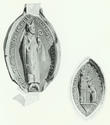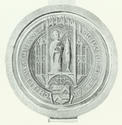Personalities
By Ted Cowan
 If there were Rab Ha's and Dougal Grahams in Glasgow before the Reformation the absence of evidence obscures them from our view. Medieval sources seldom permit us to distinguish individuals of the subordinate classes. Thus if early Glasgow seems faintly recognisable, the folk who inhabited it do not, save for a few clerics, and these are usually of fairly elevated rank. A few examples will suffice.
If there were Rab Ha's and Dougal Grahams in Glasgow before the Reformation the absence of evidence obscures them from our view. Medieval sources seldom permit us to distinguish individuals of the subordinate classes. Thus if early Glasgow seems faintly recognisable, the folk who inhabited it do not, save for a few clerics, and these are usually of fairly elevated rank. A few examples will suffice.
Bishop de Bondington
 A typical achiever was Bishop William de Bondington (1233-1258) who rebuilt and greatly expanded the cathedral. Something of his determination is revealed in his granting of indulgences to people who coughed up for the project - sins forgiven for money given, abrogation for cash donation. To make sure that folk fully understood the offer, the indulgence deal was to be written, and announced, "in the vulgar tongue". He employed similar methods to raise funds to build a church and accommodation for the Black Friars, still commemorated in the street of that name.
A typical achiever was Bishop William de Bondington (1233-1258) who rebuilt and greatly expanded the cathedral. Something of his determination is revealed in his granting of indulgences to people who coughed up for the project - sins forgiven for money given, abrogation for cash donation. To make sure that folk fully understood the offer, the indulgence deal was to be written, and announced, "in the vulgar tongue". He employed similar methods to raise funds to build a church and accommodation for the Black Friars, still commemorated in the street of that name.
Bishop Wishart
 A definite character, and one of Scotland's national heroes, was Bishop Robert Wishart (1272-1316). He it was who allegedly used the timber from the cathedral's bell-tower, or campanile, to make mangonels (or catapults) for use in the defense of his country. When Edward I demanded recognition of his superiority Wishart responded that Scotland had always been free and owed homage to no one save God alone. He argued that the kingless nation could not submit to another. As Robert Renwick observed, Wishart's besetting sin was patriotism, over-riding his most solemn oaths and his allegiance to the Church, even to the point of jeopardising his immortal soul. He donned armour and chain mail to support Wallace's rising. He was imprisoned by the English and reprimanded by the Pope who described him as "a rock of offence and a stone of stumbling, prime instigator and promoter of the fatal disputes" between Edward and the Scots. Six times the bishop swore fealty to Edward and six times he reneged. When Robert Bruce made his bid for the throne in 1306 Wishart backed him, granting him absolution for the killing of the Red Comyn, and helping to organise his inauguration at Scone. Shortly thereafter he was again captured and remained a prisoner almost until his death. The Pope was told that Wishart had stirred up the Scots to rebellion, had broken his oaths to the English king, and had been the source of many conspiracies: had been "not peaceful but warlike, not a priest but a knight on horseback, with a shield instead of a censer, a sword instead of a surplice, a breastplate instead of a tunic, a helmet instead of a bishop's mitre, or hat, and a lance instead of a pastoral staff". He was, in short, the very man to defend his nation's freedom and independence to the last.
A definite character, and one of Scotland's national heroes, was Bishop Robert Wishart (1272-1316). He it was who allegedly used the timber from the cathedral's bell-tower, or campanile, to make mangonels (or catapults) for use in the defense of his country. When Edward I demanded recognition of his superiority Wishart responded that Scotland had always been free and owed homage to no one save God alone. He argued that the kingless nation could not submit to another. As Robert Renwick observed, Wishart's besetting sin was patriotism, over-riding his most solemn oaths and his allegiance to the Church, even to the point of jeopardising his immortal soul. He donned armour and chain mail to support Wallace's rising. He was imprisoned by the English and reprimanded by the Pope who described him as "a rock of offence and a stone of stumbling, prime instigator and promoter of the fatal disputes" between Edward and the Scots. Six times the bishop swore fealty to Edward and six times he reneged. When Robert Bruce made his bid for the throne in 1306 Wishart backed him, granting him absolution for the killing of the Red Comyn, and helping to organise his inauguration at Scone. Shortly thereafter he was again captured and remained a prisoner almost until his death. The Pope was told that Wishart had stirred up the Scots to rebellion, had broken his oaths to the English king, and had been the source of many conspiracies: had been "not peaceful but warlike, not a priest but a knight on horseback, with a shield instead of a censer, a sword instead of a surplice, a breastplate instead of a tunic, a helmet instead of a bishop's mitre, or hat, and a lance instead of a pastoral staff". He was, in short, the very man to defend his nation's freedom and independence to the last.
Archbishop Blackadder
 King James IV (1488-1513) appears to have been somewhat attached to Glasgow Cathedral of which he was an honorary canon. Robert Blackadder was Bishop of Glasgow 1482 to 1492, in which latter year he became Archbishop, a position he held until his death in 1508. When James succeeded in 1488 he appointed the bishop Ambassador to the English Court. Diplomacy became Blackadder's specialty. In subsequent years he served on embassies to France, to the Spain of Christopher Columbus, and to Leonardo Da Vinci's Milan. So impressed by him were Ferdinand and Isabella of Spain that they asked the Pope to make him a cardinal. According to John Knox, Blackadder prosecuted the Lollards of Kyle who were forerunners of the Protestant reformers.
King James IV (1488-1513) appears to have been somewhat attached to Glasgow Cathedral of which he was an honorary canon. Robert Blackadder was Bishop of Glasgow 1482 to 1492, in which latter year he became Archbishop, a position he held until his death in 1508. When James succeeded in 1488 he appointed the bishop Ambassador to the English Court. Diplomacy became Blackadder's specialty. In subsequent years he served on embassies to France, to the Spain of Christopher Columbus, and to Leonardo Da Vinci's Milan. So impressed by him were Ferdinand and Isabella of Spain that they asked the Pope to make him a cardinal. According to John Knox, Blackadder prosecuted the Lollards of Kyle who were forerunners of the Protestant reformers.
 Blackadder was one of the ambassadors appointed to negotiate the marriage between King James and Margaret Tudor, daughter of Henry VII of England and sister of the future Henry VIII, the contract for which was signed on 24 January 1502. It can be assumed from his high office and his friendship with the king that Blackadder was the chief negotiator. A concomitant of the marriage agreement was a Treaty of Perpetual Peace between the two countries, a remarkable achievement which was greatly to Blackadder's credit. On 1 August 1503 he greeted the 13 year-old Princess Margaret at Lamberton Kirk on near Edinburgh, and he officiated, alongside the Archbishop of York, at the marriage of the Thistle and the Rose at Holyrood Abbey on 8 August.
Blackadder was one of the ambassadors appointed to negotiate the marriage between King James and Margaret Tudor, daughter of Henry VII of England and sister of the future Henry VIII, the contract for which was signed on 24 January 1502. It can be assumed from his high office and his friendship with the king that Blackadder was the chief negotiator. A concomitant of the marriage agreement was a Treaty of Perpetual Peace between the two countries, a remarkable achievement which was greatly to Blackadder's credit. On 1 August 1503 he greeted the 13 year-old Princess Margaret at Lamberton Kirk on near Edinburgh, and he officiated, alongside the Archbishop of York, at the marriage of the Thistle and the Rose at Holyrood Abbey on 8 August.
 The Archbishop was devoted to St Kentigern and he greatly embellished Glasgow Cathedral, notably adding the Blackadder Aisle. In 1508 he went off on pilgrimage to the Holy Land. He stopped off in Venice where he witnessed the Doge casting a gold ring into the Adriatic in the annual celebration of the marriage between Venice and the sea. Later that year he died in the vicinity of Jerusalem.
The Archbishop was devoted to St Kentigern and he greatly embellished Glasgow Cathedral, notably adding the Blackadder Aisle. In 1508 he went off on pilgrimage to the Holy Land. He stopped off in Venice where he witnessed the Doge casting a gold ring into the Adriatic in the annual celebration of the marriage between Venice and the sea. Later that year he died in the vicinity of Jerusalem.
Archbishop Beaton
By the 16th century the evidence for the history of the city of Glasgow, as of the rest of the country, becomes more abundant. Archbisop James Beaton held office in Glasgow (1509-1522) before moving to St Andrews. He was Lord High Treasurer of Scotland and an enthusiastic courtier. John Knox was not far wrong when he stated that Beaton was "more careful of the world than he was to preach Christ, or yet to advance any religion but for fashion only: and as he sought the world it fled him not". He lived in some splendor at the Bishop's Castle opposite Provand's Lordship on Castle Street. After the Battle of Flodden, as Chancellor of Scotland, he became fully embroiled in secular politics as a quarrelsome individual somewhat lacking in diplomatic skills. His great nephew, also James, became the last medieval Archbishop of Glasgow in 1551, but at the Reformation he was forced to flee to the Continent, taking many of the cathedral muniments and possessions with him. He remained in life-long exile, plotting against the protestant regime back home.
Contumacious Characters
Some true characters pop up in court records of the first James Beaton. We would like to know more about Andrew Birkmyre, for example, who had a quarrel with Martin Rede, an important office-bearer in the diocese of Glasgow. Birkmyre complained of Rede's bias against him, that it was not in Rede's power to control him and tell him what to do, or as he put it, "to fasten and bind his feet". When Birkmyre was ordered to withdraw, he was heard to say that Rede "could not even fasten a sheep's heid", and declared "I do not give a fart for you!" Birkmyre was forced to submit and do penance, but reluctantly, "only to please the archbishop and not otherwise".
Another "contumacious person" was John Gibson, Prebendary of Renfrew, who, when departing on pilgrimage to Rome, announced that he was placing his prebend and his property under the protection of the Pope while he was away; he clearly did not trust his thieving clerical colleagues in the cathedral. Another priest, George Kirkhope, was charged with murder though the outcome, like so much else about medieval Glasgow, is unknown.